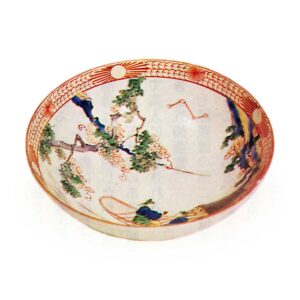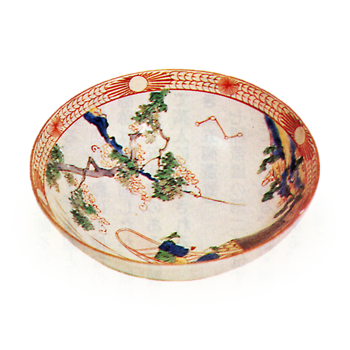
Koto-Yaki was the domain kiln of the Marquis Ii of Hikone in Omi Province (Hikone City, Shiga Prefecture). It was originally located at the foot of Mt. Sawa in Furusawa Village (Furusawa-cho, Hikone City) near Hikone, but later expanded to include Hikone Yanagimachi and Ishigasaki Village (Ishigasaki Town). The period of continuity was over 20 years, from September 1842 to August 1862.
History] When Naosuke Ii, the 14th generation of the Ii family, was in the position of Grand Elder of the Tokugawa Shogunate, he was annoyed by the extravagance of the times and the elaborate gifts from various lords and princes, and happened to have a favorite retainer, Onoda Koichiro, who liked Raku ware, offer him the kiln of Kinuya Hanbei in Furusawa Village in September 1842. This was the origin of Koto Pottery, the domain kiln. In 1845 (Koka 2), a five-kiln round kiln was built to fire large quantities of high-quality porcelain, and a wholesaler system was established to handle sales within the domain. In October 1850, Naoaki died, and Naosuke succeeded him in November 1850. Naosuke was a great connoisseur of the tea ceremony and devoted himself to the improvement of Koto pottery for many years. In 1854, Shirobei left the kiln with a loss of 1,500 ryo, In March 1859, Naosuke granted 1,000 ryo of his allowance, and various other maintenance measures were taken, but on March 3, 1860, Naosuke met with difficulties and died. However, Naosuke died on March 3, 1860, and Koto Yaki also suffered from bad luck. In 1862, when the land was suddenly reduced to 100,000 koku, it was decided to abolish the pottery business immediately.
The pottery industry was discontinued in 1862, when the government suddenly ordered a reduction in the amount of land to 100,000 koku (about $100,000). Because it was easy to obtain the originals and there were many potters with specialized skills, there were a wide variety of copies, including underglaze blue, akae, Koshu akae, celadon, Oribe, Shino, Takatori, Zensho, Iga, Kokutani, Kutani, Toyosuke, Imari, Nisei, Kenzan, Annan, Kotsuji, Shidoro, Untsuru and Koryo. In Naosuke’s time, there were many elaborate and gorgeous brocade and nishiki-te (brocade with gold brocade) pieces in particular, and Kosai and Meiho were masters of this art. Naosuke took up this art as his own and succeeded in removing the bluish tinge from the base by first blending Monoseizan clay. The painted patterns are diverse, and many of them are imitations of China, such as “Hyakuro,” “16 Arhats,” “Seven Sages of Bamboo Forest,” “Lanting,” “Akakabe,” “Kotogi,” “Four Princes,” “Ten Friends,” “Gyudo,” “Pine, Bamboo and Plum,” “Landscape,” “Flower and Bird,” “Ox, Horse,” “Peacock,” “Phoenix and Phoenix,” “Kirin and Lion,” “Cloud and Crane,” “Treasure,” and “Baojin. Another trend of Koto ware is that literati paintings were actively produced by literati poets and poets in the domain, including Naosuke.
The inscriptions of the Naoaki period mainly used the two characters of Koto, but other inscriptions include “Awai Hikonjo,” “Kinkame Santo,” “Kinkamejo Higashi,” and “Kinkameyama Seisaku. This is because Mt. Hikone is called “Kinkeizan” and Chawanzan is located to the east of it. There are also some that simply write the character for “lake. Next, Naosuke wished to promote Koto ware and required that the name of the bowls be inscribed with the two characters of Koto, and forbade the use of any other name or the name of the craftsman. However, there are many unmarked pieces, and it is difficult to determine the quality of a product by the presence or absence of an inscription. The inscriptions were also written by painters and servants, and thus the typefaces varied, making it impossible to determine the author by the inscriptions. There are two types of engravings: one large and one small with “Koto” within the outline of the turtle (the shape of the turtle differs), two large and two small engravings with “Koto” in sloman script within a double koban, one engraving with “Koto Okato-Koto” within a circle, and another engraving with “Koto” in standard script within a double koban, which was made by the order of Naosuke in 1856. Among the copies, there are some with Kutani, Kakufuku inscriptions, made in Seika, and made in the Taicheng Jiaqing year. Koto ware, which was produced in the domain kilns mentioned above, was extremely large in scale and developed in a unique way. According to the legend, Naosuke himself gave designs to each product or made detailed corrections and supplementary writings. Shimizu Rokubei III, Mizukoshi Yosampei, Wakekameitei III, and Eirakucho were also engaged in this work.
The above is a brief description of Koto Pottery in the domain kiln, but Koto Pottery in the broader sense includes the Kinuya Kiln before the domain kiln and the Yamaguchi Kiln after the domain kiln. There is also Raku ware produced by Naosuke and other clan members. There is also Akasui, Tokozan, Shizenzai, and Kenyu, all of whom were involved in the private sector at the time of the domain kilns. There are also various kilns such as Toshimanji-yaki, Kyuhei-yaki, Bunsuke-yaki, Kameshichi-yaki, Maruyama Koto-yaki, Kitagawa-yaki, Higuchi-yaki, and Nagahama Koto-yaki, each with the name of Koto, so it cannot be assumed that Koto-yaki was produced simply because it is called “Koto”. See each section. (Koto-yaki no Kenkyu [Study of Koto Pottery])



